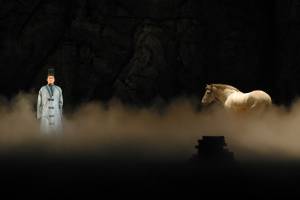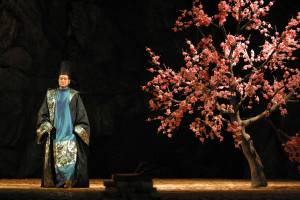The Orphan of Zhao (Zhaoshi guer)
Genre: huaju (modern spoken drama)
Produced by Beijing People’s Art Theatre, 2003
Playwright: Jin Haishu
Director: Lin Zhaohua
Stage and Lighting Designer: Yi Liming
Costume Designer: Cheng Shuyi
Music and Sound Designer: Zhang Jian
Performers: Pu Cunxin, He Bing, Li Shilong, Xu Fan
Scenario:
The Orphan of Zhao is a play based on historical records. [Link to the Exhibition] The orphan was born circa 583 BC during the Spring-Autumn Period – a time when imperial power was being eroded by the growth of numerous aristocratic-family-states. Appalled by the chaos and bloodshed, philosophers such as Confucius (551-479 BC) acted as advisors to rulers on how to control their states and people.
Historical records present contradictory accounts of the story. Most versions of different theatrical genres and films we see now are based on the extant full-length tragedy Wrongs Avenged by the Orphan of Zhao by Ji Junxiang, written in the Yuan dynasty when China was ruled by the Mongols (1279-1368 AD).
The basic story is as follows: schemed by the evil courtier Tu’an Gu, the Zhao clan were all killed except for the Princess who was the Jin Ruler’s sister and was pregnant. After the baby was born, he was smuggled out by a doctor called Cheng Ying. Having realized that the baby boy had escaped, Tu’an Gu gave the order to kill all the newly born boys in the country. Finally, Cheng Ying decided to give up his own child for the Zhao orphan. Meanwhile Cheng Ying and his friend, a retired minister Gongsun Chujiu made a plan. Cheng would report to Tu’an about Gongsun who had the Zhao orphan in his house. Actually the real Zhao orphan was hidden in the deep mountain while Cheng’s own baby son was with Gongsun. Tu’an killed both Gongsun and the child. In order to reward Cheng Ying as a loyal reporter, Tu’an took both Cheng Ying and his son (but actually Zhao’s offspring) to his house and Tu’an made himself the foster father of the boy.16 years later, Cheng Ying revealed the true story to the young man. The orphan of Zhao took the revenge on Tu’an, for his parents, grandparents, his clan and for Cheng Ying. In order to rescue this orphan many people died.
This is an archetypal Chinese story of loyalty, honesty, sacrifice, friendship, evil, revenge, bravery, and justice.
This clip is taken from the production by Beijing People’s Art Theatre, which is the Chinese equivalent of the Royal Shakespeare Company in Britain. [LINK http://www.china.org.cn/english/features/Festival/143211.htm] Established by the leading dramatist Cao Yu and his colleagues, in 1952, the theatre has produced over 300 plays over the past 60 years and established BPAT’s own style.
The director of this huaju production is Lin Zhaohua (1936- ), [LINK: Staging China Book chapter 2] one of the most controversial contemporary directors in the Chinese theatre. His experimental theatre work in the 1980s (see huaju), with Nobel Literature Prize winner Gao Xingjian [external LINK Gao Xingjian] has been regarded as the most important “revolution” in the modern spoken drama realm, because their series of productions overthrew the orthodoxy about “what is theatre and what theatre should look like”.
Again, among differing productions of The Orphan of Zhao, his was the most controversial because the work turned archetypal heroism ironically into a critique on “loyalty”. In this production, the orphan refuses Cheng Ying’s request for taking revenge on Tu’an Gu. He cannot understand why Cheng Ying has given up his own son for him; he is also grateful to his foster father Tu’an. Furthermore, the young man feels no responsibility towards his family or those who have rescued him. “No matter how many people died, they are nothing to do with me,” he cries out. The clip clearly shows the gaps between two generations over life, values and morality. Viewers can also see the beautiful set made of 40,000 orange-red bricks.
Images and the video are courtesy of Beijing People’s Art Theatre.
《赵氏孤儿》
剧种:话剧
演出单位:北京人民艺术剧院
编剧:金海曙
导演:林兆华
舞美灯光设计:易立明
服装设计:成曙一
音乐音响设计:张荐
演员:濮存昕、何冰、李士龙、徐帆
剧情简介:
《赵氏孤儿》是一个春秋时代的故事。〔LINK 展览〕。据史书记载,孤儿出生于公元前583年左右。当时受到“分封制”诸侯日益强大势力的侵蚀,周王权日益衰微,诸侯争霸称雄,战争与血腥屠杀连年不断。同时,诸子百家学说开始出现,并试图就如何管理国家和人民等等给予统治者以哲学性的思考。
史书有着互相矛盾的关于赵氏孤儿的记载。我们现在所看到的各种戏剧形式和电影版本基本上来自于元代纪君祥的《冤报冤赵氏孤儿》。
大致故事如下:奸臣屠岸贾设计将与自己不和的赵氏家族满门抄斩,唯一幸免的是已有身孕的、赵朔的妻子庄姬,她是晋王室的公主。男婴出生以后,就被一位叫作程婴的医生想办法带出了宫苑。当屠岸贾听说婴儿已经逃遁,便下令杀死举国上下所有在这段时期内出生的男婴。几经考量,程婴决定献出自己的亲生儿子以保全赵家唯一的骨血。与此同时,程婴和老友、已经告老还家的公孙杵臼安排了救孤的计划。程婴前往屠岸贾处报告公孙杵臼藏匿了赵氏的孤儿,而实际上,真正赵家的孤儿被藏在深山之中,而公孙那里的婴儿恰恰是程婴自己的孩子。屠岸贾杀死了公孙杵臼和婴儿,为报答程婴举报之功,他把程婴及其儿子(是真正的赵氏孤儿)接回自己家里,好生款待,并把男孩作为自己的养子来呵护养育。孤儿长大成人以后,程婴将孤儿的身世告诉了他本人。为给自己的父母、祖父母、赵氏家族以及为程婴报仇,孤儿杀死了屠岸贾。为了拯救孤儿,诸多英雄献出自己的生命。
《赵氏孤儿》是关于忠义、诚信、牺牲、友情、奸佞、报仇、勇猛和正义的中国原型。
选取的片断来自北京人民艺术剧院的演出,该剧院于1952年建立,是中国话剧界最重要的剧院之一,曹禺为第一任院长直至他去世。成立60多年以来北京人艺创作、演出了300多部剧目,并建立了北京人艺独特的演剧风格。[LINK http://www.bjry.com]
该剧的导演为林兆华(1936- ),是中国戏剧舞台上最具争议的导演之一。他在80年代与诺贝尔文学奖获得者高行健一起创作的一系列实验戏剧是中国话剧界最为重要的“革命”,他们的作品彻底颠覆了“什么是戏剧?”以及“话剧应该是什么样子的?”这类非常重要的观念。
同样,在众多《赵氏孤儿》的作品中,林兆华的版本争议最大,因为他改变了原剧中英雄主义的原型,作品是对于 “忠义”这类中国传统美德的质问。在这部演出中,孤儿拒绝了程婴所提出的向屠岸贾复仇的要求,他完全不能理解为什么当年程婴会牺牲自己亲生的儿子去救他。而他对于养父屠岸贾也具有相当的感激之情。更为重要的是他对于家庭以及为拯救他的生命而牺牲的所有的人丝毫没有责任感,他对着也是自己的养父程婴大喊:“不管有多少条人命,它跟我也没有关系。”这一片断显示了两代人之间关于生命、价值与道德观念的差距。观者也可以看到该剧著名的使用了四万块红砖的舞台布景。
诚挚感谢北京人民艺术剧院提供图片与录像。


